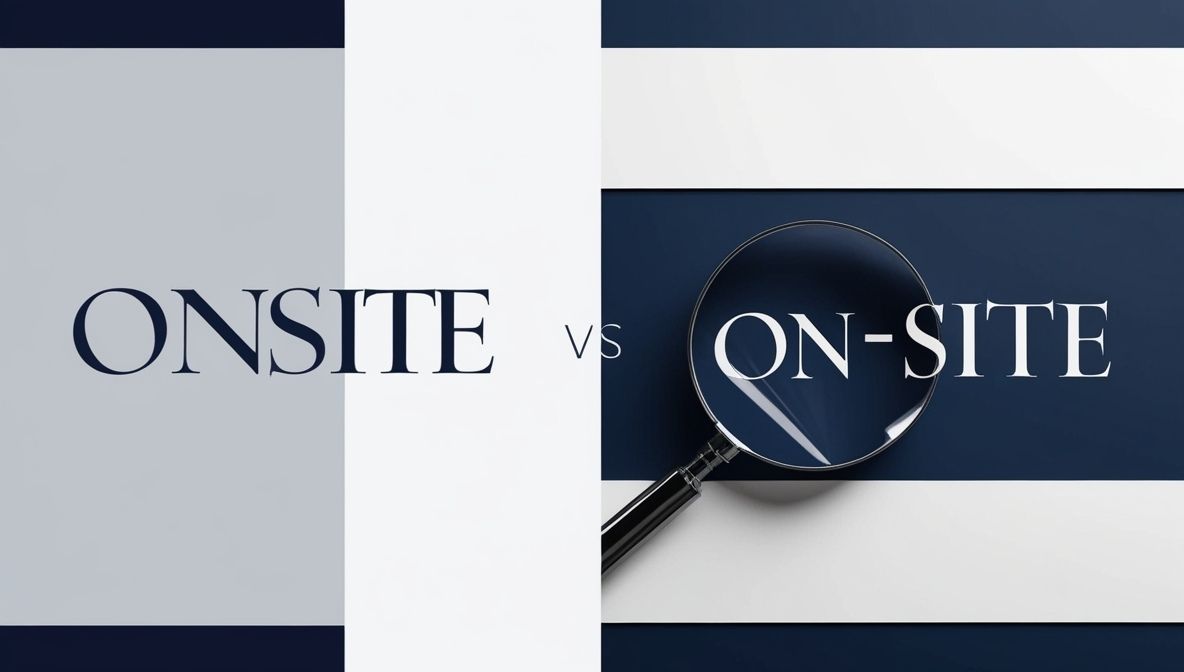Choosing the correct form “Onsite or On-Site” can impact the clarity and professionalism of your writing. Though they appear similar, their usage differs depending on the level of formality, context, and audience. In business communication, technical writing, and industry specific documentation, knowing when to use the hyphenated form is essential for maintaining consistency and credibility.
This article explores the subtle but important distinctions between the two. You’ll learn the correct usage in formal and informal settings, how various style guides treat the term, and why proper usage matters in fields like IT, construction, and event management. By the end, you’ll be able to choose the right form with confidence and precision.
Understanding the Basics of Onsite and On‑Site
Both terms are grammatically correct, but they’re used in slightly different ways depending on tone, formality, and audience. In short:
- “On‑site” is the traditional, hyphenated form—preferred in formal and academic settings.
- “Onsite” is the modern, simplified version—commonly used in casual, marketing, or digital content.
Understanding this distinction is crucial for clarity in professional writing, especially when you’re aiming for consistency across platforms or documentation.
Definitions and Real-World Use Cases
Let’s unpack both terms with clarity.
- On‑site (hyphenated): A compound adjective that modifies a noun. It implies something happens at a specific physical location. Example: “We require an on‑site inspection before issuing permits.”
- Onsite (one word): A more streamlined version, often used in internal communications or brand messaging. It serves the same function but leans toward modern writing conventions. Example: “We offer onsite support to all employees.”
Synonyms:
- In-house
- At the premises
- Locally available
- On the location
Tip: Use “on‑site” in formal documents. Use “onsite” in casual, internal, or digital environments.
Common Examples by Industry and Scenario
To understand the onsite vs on‑site usage, context is everything. Here are some practical scenarios:
| Industry | Preferred Form | Example Sentence |
|---|---|---|
| Construction | on‑site | “The engineer conducted an on‑site inspection.” |
| IT / Tech Support | onsite | “We offer 24/7 onsite support.” |
| Education | on‑site | “The training will take place at the on‑site facility.” |
| Event Management | onsite | “All onsite staff must report by 7 AM.” |
| Government / Legal | on‑site | “All documents must be signed on‑site.” |
Tip: Choose the spelling that fits the tone of the message. Formal? Go with on‑site. Branding or marketing? Use onsite.
What Style Guides Say
Let’s take a closer look at how major writing authorities treat the hyphenation issue:
- AP Style: Strictly uses “on‑site” as a hyphenated adjective. Example: “The reporter visited the on‑site location.” They do not recognize “onsite” as a standard form.
- Chicago Manual of Style: Also prefers “on‑site,” but is more flexible in informal or digital writing. In internal documents or blogs, “onsite” may be acceptable depending on your brand tone.
Tip: If you’re writing for the public, a client, or press stick to what the style guide recommends. If you’re unsure, go with on‑site to play it safe.
How to Decide: Onsite or On‑Site?
Here’s a simple decision guide to help you choose:
| Usage Type | Recommended Form | Reason |
|---|---|---|
| Formal writing / documentation | on‑site | Aligns with traditional grammar rules |
| Internal or informal communication | onsite | Simpler, faster, widely understood |
| Branding or marketing materials | onsite | Modern feel, visually cleaner |
| Technical or legal language | on‑site | Ensures clarity and reduces misinterpretation |
Tip: Stay consistent within each document or platform. Mixing both forms weakens your credibility.
Why the Confusion Exists
English evolves. Words that were once hyphenated like email (e‑mail) and online (on‑line) gradually lost their hyphens as usage shifted. The same evolution is happening with onsite.
But not all contexts adapt at the same speed. In legal, academic, or official writing, precision is key. So while “onsite meaning in business context” might feel fine for internal emails, an external client report should likely stick with “on‑site”.
Tips to Avoid Mistakes
- Learn your organization’s style guide. If you’re in publishing or journalism, AP Style is likely required.
- Scan for consistency. Use “Find and Replace” tools to fix mixed usage across long documents.
- Write based on audience. A customer reading a product manual expects on‑site clarity. A colleague reading Slack messages doesn’t care.
- Avoid using “on site” as two separate words unless you’re writing a phrase like “He is currently on site.” Without a noun following it, the two-word version is fine.
Additional Scenario Examples
Here are more on-site vs onsite example sentences that show how small changes affect the tone and purpose of your sentence:
- “The CEO will visit the team on site tomorrow.” (no hyphen, used after the verb)
- “We provide on‑site IT support for enterprise clients.” (hyphenated adjective before noun)
- “Our onsite app developer can help with custom features.” (modern usage in tech)
- “All packages will be delivered on site, weather permitting.” (standard phrasing)
FAQs
Is onsite one word or two?
“Onsite” is one word in informal writing; “on‑site” is preferred in formal writing and before nouns.
When should I use onsite or on‑site?
Use “on‑site” for formal contexts or clarity; use “onsite” for casual or branded materials.
Should onsite be hyphenated?
Yes, if it’s acting as an adjective before a noun in formal writing. Otherwise, the one-word form is fine.
Final Thoughts
Choosing between Onsite or On-Site depends on your writing style and context. Use on site with a hyphen in formal or professional documents for clarity. Choose onsite as one word in casual or industry specific communication. Both forms mean the same thing but suit different situations. Remember to stay consistent once you pick one. This way, your writing will look clean and professional. Understanding the difference helps you communicate better and avoid confusion. Now, you can confidently use onsite or on-site in your writing.
